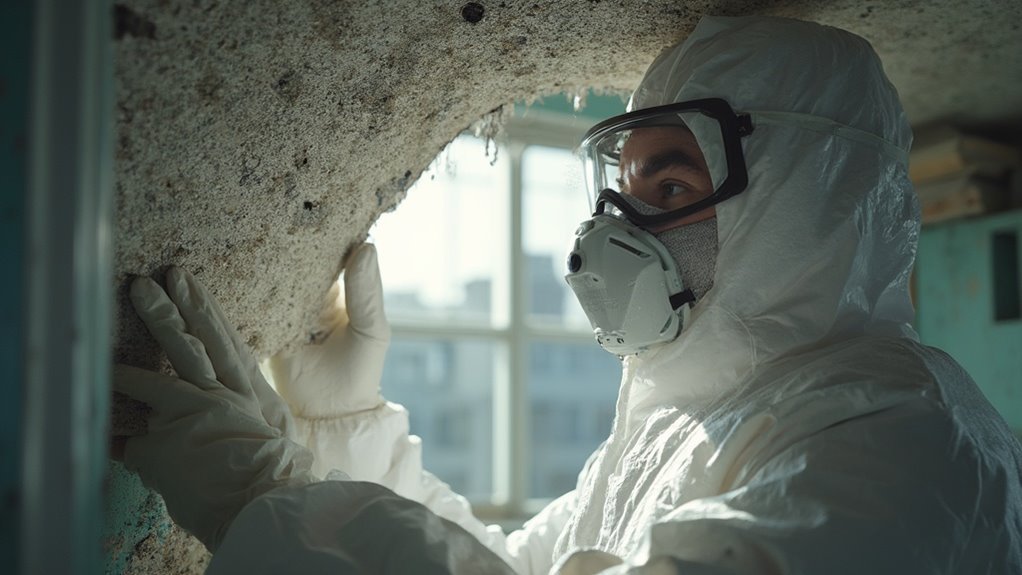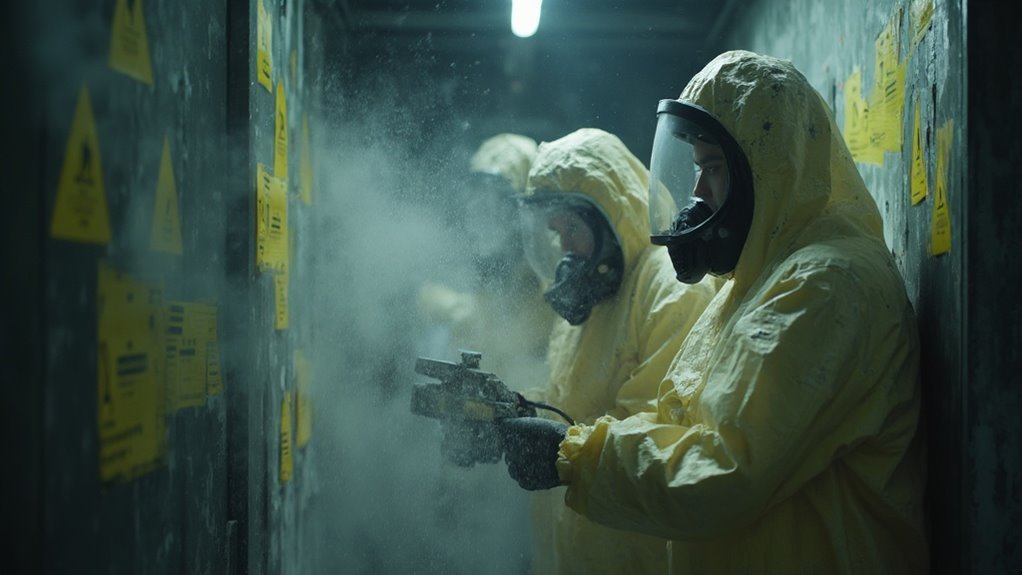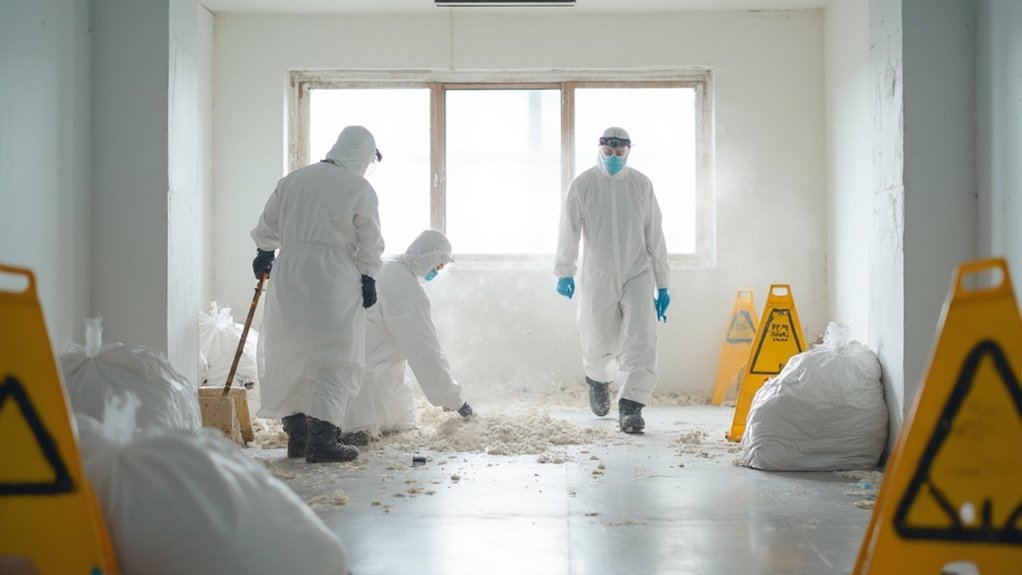To keep your property safe from asbestos, start with a professional assessment to identify its presence, especially in older buildings. Planning for removal is vital, so prepare your environment by sealing off affected areas and clearing belongings. Always use certified experts for safe removal using techniques like wet methods to minimize airborne fibers. Disposal of asbestos must follow strict regulations; double-bag materials and use labeled containers. After cleanup, conduct air testing to confirm no lingering hazards. This guide provides foundational knowledge, but you'll find even more important tips to solidify your strategy for asbestos safety.
Understanding Asbestos and Its Risks

Understanding asbestos and its associated risks is vital for maintaining a safe environment, especially in older buildings where this hazardous material may be present. Asbestos refers to a group of six naturally-occurring fibrous minerals, primarily categorized into two groups: serpentine and amphibole. Serpentine asbestos, chiefly chrysotile, features long, flexible fibers, while amphibole asbestos consists of straight, needle-like fibers. Asbestos mining in Canada ceased in 2012, highlighting the importance of awareness and management of existing materials.
Asbestos has a long history of use because of its remarkable properties, including resistance to heat, fire, and chemicals. Nevertheless, these same properties make it a health hazard when fibers become airborne. Exposure to any type of asbestos greatly increases the risk of severe health implications, including lung cancer, mesothelioma, and asbestosis. Significantly, symptoms often manifest 20 to 50 years post-exposure, making early detection challenging. Regular testing is essential to ensure safety in environments where asbestos might be present.
To mitigate these risks, it's imperative to manage asbestos-containing materials properly. If materials are undisturbed and in good condition, they commonly pose minimal risk. Yet, any damage or improper removal can release harmful fibers into the air, underscoring the need for professional intervention during renovations or repairs.
Planning for Asbestos Removal
Once you've recognized the risks associated with asbestos, planning for its removal becomes the next critical step. Begin with an asbestos assessment conducted by a licensed inspector. This detailed inspection identifies areas containing asbestos, focusing on common locations like insulation materials, floor tiles, and roofing shingles. If your building is in a jurisdiction requiring a Designated Substance Survey, verify this is completed before any major renovations.
After the assessment, establish a removal timeline that outlines when the work will occur, taking into consideration the extent of the asbestos presence. Prepare the building by clearing personal belongings and sealing work areas with plastic sheeting to prevent fiber dispersion. You'll need to shut down HVAC systems and possibly arrange for temporary relocation of occupants and pets during the process. It's also essential to engage certified professionals to ensure a safe and effective removal.
Finally, confirm all necessary equipment and materials are onsite before commencing the work. This thorough preparation not only protects your property but additionally safeguards the health of everyone involved. By taking these steps, you're laying the groundwork for a safe and effective asbestos removal.
Safe Removal Techniques

Effective asbestos removal requires meticulous attention to safe techniques that minimize health risks. Start by preparing the area: seal it off with polyethylene sheeting and duct tape to create a containment enclosure. This prevents asbestos fibers from spreading during the process. Use negative air pressure units with HEPA air filtration systems to guarantee any fibers that escape are captured.
When removing asbestos-containing materials (ACMs), employ wet removal techniques. This involves saturating ACMs with water mixed with a surfactant to reduce airborne fibers. Controlled dismantling is vital; carefully disassemble materials to minimize fiber release. Avoid any actions, such as drilling or sanding, that could agitate the ACMs and release fibers into the air.
Throughout the removal process, wear appropriate personal protective equipment (PPE) like respirators with HEPA filters, coveralls, and gloves to protect against inhalation and skin contact. Regularly inspect the containment area for breaches and monitor air quality to guarantee safety. By implementing these safe removal techniques, you can effectively minimize health risks associated with asbestos exposure and guarantee a safer environment during the removal process.
Proper Disposal and Cleanup
After safely removing asbestos-containing materials, proper disposal and cleanup are vital to confirm that no hazardous fibers remain in the environment. You need to follow specific disposal methods and cleanup procedures to guarantee safety.
| Disposal Methods | Cleanup Procedures |
|---|---|
| Use specialized, labeled containers | Utilize HEPA vacuums for dust removal |
| Wet materials to prevent fibers | Employ wet wiping and damp mopping |
| Double bagging in 6-millimeter bags | Seal the work area with plastic sheeting |
| Dispose at certified landfills | Conduct air testing to check fiber levels |
Begin by placing the materials in sealed containers and double-bagging them. Confirm all materials are wetted to minimize airborne fibers. For cleanup, use HEPA-filter vacuums and wet cleaning methods to remove any remaining debris. It's critical to seal the work area to prevent contamination during this process. Finally, perform air testing to verify asbestos levels meet regulatory standards. Following these steps diligently will help you maintain a safe environment post-removal.
Ensuring Compliance and Safety

Guaranteeing compliance and safety during asbestos removal is essential to protect both workers and the public from hazardous exposure. You need to be aware of the various regulatory agencies and compliance protocols that govern asbestos handling. Understanding these requirements can prevent legal issues and guarantee a safe working environment.
To effectively manage compliance and safety, consider the following:
- Consult Regulatory Agencies: Always check federal, state, and local regulations to understand the specific requirements for your project.
- Develop a Thorough Plan: Create a detailed plan that outlines all procedures, from the initial inspection to the final cleanup.
- Hire Certified Professionals: Confirm that your team consists of certified asbestos abatement contractors who are knowledgeable about compliance protocols.
Compliance with these regulations not only safeguards public health but additionally minimizes the risk of fines and penalties. Keep accurate records of all asbestos removal activities, as regulatory agencies often require documentation. By following these guidelines, you assure a safer environment for everyone involved and adhere to the necessary legal standards.
Frequently Asked Questions
How Can I Tell if My Home Contains Asbestos?
To determine if your home contains asbestos, conduct a home inspection focusing on older materials. Consider professional asbestos testing for accurate identification, especially in insulation, flooring, and ceiling textures, to guarantee safety and compliance.
What Are the Symptoms of Asbestos Exposure?
So, you think inhaling tiny asbestos particles is harmless? Think again! Exposure symptoms include persistent cough, chest pain, and shortness of breath. Don't ignore these asbestos health effects; they could lead to serious lung conditions.
How Much Does Asbestos Removal Cost?
Asbestos removal costs vary considerably, typically ranging from $5 to $20 per square foot. You should consider asbestos disposal options and utilize asbestos testing methods to guarantee safe handling and compliance with regulations.
Can I Remove Asbestos Myself?
Removing asbestos yourself is like trying to defuse a bomb without training; it's risky. Asbestos regulations mandate safe practices, and only trained professionals can guarantee compliance and protect you from severe health hazards and legal penalties.
What Should I Do if I Accidentally Disturb Asbestos?
If you accidentally disturb asbestos, stop work immediately, evacuate the area, and notify your supervisor. Follow asbestos safety protocols and emergency procedures, ensuring no further disturbance occurs until professionals address the situation properly.
